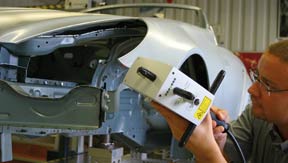Body
 |
|
Dirk Noffke, a metrology technician at DaimlerChrysler Bremen, inspects the dimensional accuracy of the left fender on a Mercedes SLK body-in-white. The comparison between the actual and CAD data is displayed in real time on an application PC running the PolyWorks Inspector software. |
…
Want to continue?
Log in or create a FREE account.
By logging in you agree to receive communication from Quality Digest.
Privacy Policy.
Add new comment